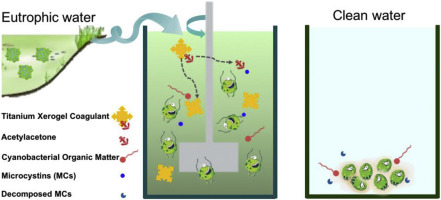当前位置:
X-MOL 学术
›
Water Res.
›
论文详情
Our official English website, www.x-mol.net, welcomes your
feedback! (Note: you will need to create a separate account there.)
Potent removal of cyanobacteria with controlled release of toxic secondary metabolites by a titanium xerogel coagulant
Water Research ( IF 11.4 ) Pub Date : 2017-10-30 , DOI: 10.1016/j.watres.2017.10.066 Xiaomeng Wang , Xin Wang , Zhongbo Wei , Shujuan Zhang
Water Research ( IF 11.4 ) Pub Date : 2017-10-30 , DOI: 10.1016/j.watres.2017.10.066 Xiaomeng Wang , Xin Wang , Zhongbo Wei , Shujuan Zhang

|
Cyanobacteria blooming is a serious environmental issue throughout the world. Removal of cyanobacterial cells from surface water with controlled release of cyanobacterial organic matter (COM), especially toxic microcystins (MCs), would potentially reduce the processing burden in follow-up water treatment. Coagulation is a key technique in water treatment. Herein, the potential application of a novel titanium xerogel coagulant (TXC) was evaluated for the treatment of cyanobacteria-laden water in terms of cyanobacteria removal efficiency, variation of cell viability, the release and evolution of COM in the floc accumulation and storage process. Under acidic to neutral conditions, TXC showed a higher removal efficiency of approximately 99% for cyanobacteria and a lower residual Ti concentration than the widely-used commercial polyferric sulfate (PFS) and polyaluminum chloride (PAC). Another advantage of TXC was the reduced MCs concentration caused by the released acetylacetone (AcAc) from the hydrolysis of TXC. Under solar irradiation, AcAc degraded the extracellular MCs from an initial concentration of 40 μg/L to a residual concentration of 7 μg/L during a 16-day floc storage process. The low residual Ti concentration (< 0.04 mg/L) and the efficient removal of COM/MCs following TXC coagulation reduced the toxicity to photobacteria. The results demonstrate that TXC is a promising dual-effect coagulant for treatment of cyanobacteria-laden water.
中文翻译:

钛干凝胶凝结剂可有效去除蓝细菌并控制有毒次生代谢产物的释放
蓝藻开花是世界范围内的严重环境问题。通过控制释放蓝细菌有机物(COM),特别是有毒微囊藻毒素(MC),从地表水中去除蓝细菌细胞,将有可能减轻后续水处理的处理负担。混凝是水处理中的关键技术。本文中,从蓝藻去除效率,细胞活力变化,絮凝物积累和储存过程中COM的释放和进化方面,评估了新型钛干凝胶凝结剂(TXC)在处理蓝藻水中的潜在应用。在酸性至中性条件下,与广泛使用的市售聚硫酸铁(PFS)和聚氯化铝(PAC)相比,TXC对蓝细菌的去除效率更高,约为99%,而残留的Ti浓度较低。TXC的另一个优点是由TXC水解释放的乙酰丙酮(AcAc)引起的MCs浓度降低。在16天絮凝物存储过程中,AcAc在阳光照射下将细胞外MC从最初的40μg/ L浓度降解为7μg/ L的残留浓度。低残留Ti浓度(<0.04 mg / L)和TXC凝结后有效去除COM / MC降低了对光细菌的毒性。结果表明,TXC是用于处理载有蓝细菌的水的有前途的双效凝结剂。TXC的另一个优点是由TXC水解释放的乙酰丙酮(AcAc)引起的MCs浓度降低。在16天絮凝物存储过程中,AcAc在阳光照射下将细胞外MC从最初的40μg/ L浓度降解为7μg/ L的残留浓度。低残留Ti浓度(<0.04 mg / L)和TXC凝结后有效去除COM / MC降低了对光细菌的毒性。结果表明,TXC是用于处理载有蓝细菌的水的有前途的双效凝结剂。TXC的另一个优点是由TXC水解释放的乙酰丙酮(AcAc)引起的MCs浓度降低。在16天絮凝物存储过程中,AcAc在阳光照射下将细胞外MC从最初的40μg/ L浓度降解为7μg/ L的残留浓度。低残留Ti浓度(<0.04 mg / L)和TXC凝结后有效去除COM / MC降低了对光细菌的毒性。结果表明,TXC是用于处理载有蓝细菌的水的有前途的双效凝结剂。低残留Ti浓度(<0.04 mg / L)和TXC凝结后有效去除COM / MC降低了对光细菌的毒性。结果表明,TXC是用于处理载有蓝细菌的水的有前途的双效凝结剂。低残留Ti浓度(<0.04 mg / L)和TXC凝结后有效去除COM / MC降低了对光细菌的毒性。结果表明,TXC是用于处理载有蓝细菌的水的有前途的双效凝结剂。
更新日期:2017-10-31
中文翻译:

钛干凝胶凝结剂可有效去除蓝细菌并控制有毒次生代谢产物的释放
蓝藻开花是世界范围内的严重环境问题。通过控制释放蓝细菌有机物(COM),特别是有毒微囊藻毒素(MC),从地表水中去除蓝细菌细胞,将有可能减轻后续水处理的处理负担。混凝是水处理中的关键技术。本文中,从蓝藻去除效率,细胞活力变化,絮凝物积累和储存过程中COM的释放和进化方面,评估了新型钛干凝胶凝结剂(TXC)在处理蓝藻水中的潜在应用。在酸性至中性条件下,与广泛使用的市售聚硫酸铁(PFS)和聚氯化铝(PAC)相比,TXC对蓝细菌的去除效率更高,约为99%,而残留的Ti浓度较低。TXC的另一个优点是由TXC水解释放的乙酰丙酮(AcAc)引起的MCs浓度降低。在16天絮凝物存储过程中,AcAc在阳光照射下将细胞外MC从最初的40μg/ L浓度降解为7μg/ L的残留浓度。低残留Ti浓度(<0.04 mg / L)和TXC凝结后有效去除COM / MC降低了对光细菌的毒性。结果表明,TXC是用于处理载有蓝细菌的水的有前途的双效凝结剂。TXC的另一个优点是由TXC水解释放的乙酰丙酮(AcAc)引起的MCs浓度降低。在16天絮凝物存储过程中,AcAc在阳光照射下将细胞外MC从最初的40μg/ L浓度降解为7μg/ L的残留浓度。低残留Ti浓度(<0.04 mg / L)和TXC凝结后有效去除COM / MC降低了对光细菌的毒性。结果表明,TXC是用于处理载有蓝细菌的水的有前途的双效凝结剂。TXC的另一个优点是由TXC水解释放的乙酰丙酮(AcAc)引起的MCs浓度降低。在16天絮凝物存储过程中,AcAc在阳光照射下将细胞外MC从最初的40μg/ L浓度降解为7μg/ L的残留浓度。低残留Ti浓度(<0.04 mg / L)和TXC凝结后有效去除COM / MC降低了对光细菌的毒性。结果表明,TXC是用于处理载有蓝细菌的水的有前途的双效凝结剂。低残留Ti浓度(<0.04 mg / L)和TXC凝结后有效去除COM / MC降低了对光细菌的毒性。结果表明,TXC是用于处理载有蓝细菌的水的有前途的双效凝结剂。低残留Ti浓度(<0.04 mg / L)和TXC凝结后有效去除COM / MC降低了对光细菌的毒性。结果表明,TXC是用于处理载有蓝细菌的水的有前途的双效凝结剂。











































 京公网安备 11010802027423号
京公网安备 11010802027423号